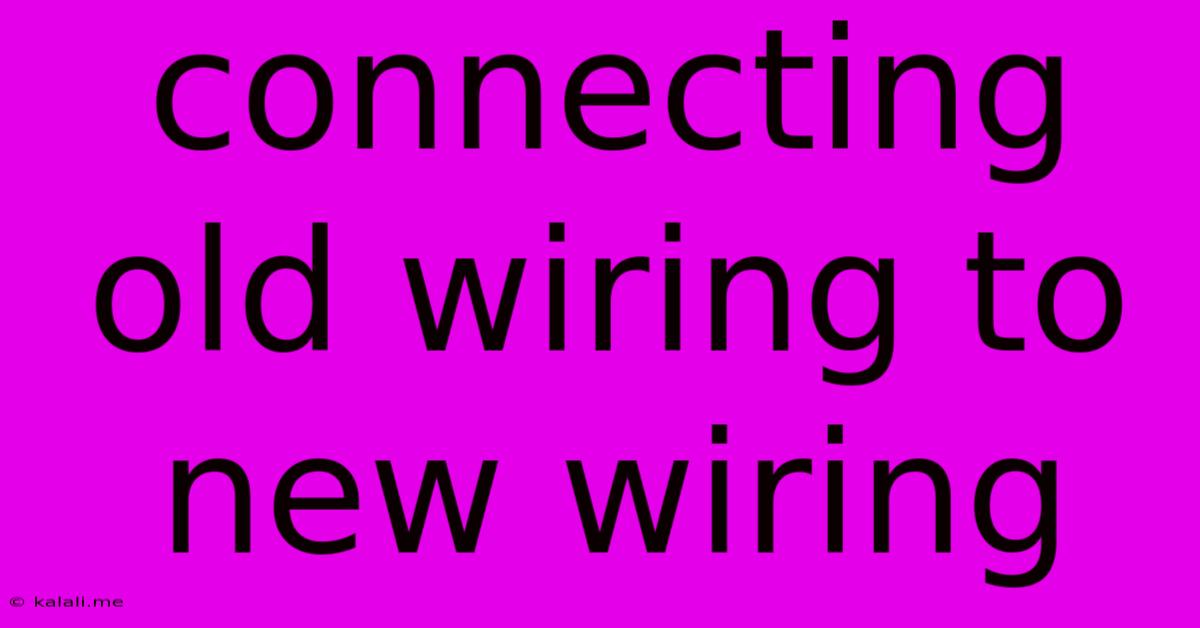Connecting Old Wiring To New Wiring
Kalali
May 22, 2025 · 3 min read

Table of Contents
Connecting Old Wiring to New Wiring: A Safe and Practical Guide
Connecting old wiring to new wiring is a common task during home renovations or electrical upgrades. This process requires careful attention to safety and adherence to local electrical codes. Improperly connecting old and new wiring can lead to fire hazards, electrical shocks, and equipment damage. This guide provides a comprehensive overview of safe and effective techniques for this critical task.
Before you begin any electrical work, always turn off the power to the circuit at the breaker box. Verify the power is off using a non-contact voltage tester. Safety should always be your top priority.
Assessing the Existing Wiring
The first step is to carefully examine the old wiring. Determine the type of wiring (e.g., knob and tube, aluminum, or copper wiring), its gauge, and its condition. Older wiring, especially knob and tube, may be brittle and prone to damage. If the old wiring is damaged, deteriorated, or doesn't meet current electrical codes, it's crucial to replace it entirely rather than connecting to it.
Look for signs of:
- Brittle insulation: This is a major red flag indicating potential failure.
- Corrosion or discoloration: This suggests potential oxidation and degradation of the wire.
- Loose connections: These can create overheating and fire hazards.
Choosing the Right Connection Method
The method you use to connect old wiring to new wiring depends largely on the type of wire and its condition. Here are some common methods:
-
Wire nuts (wire connectors): These are a versatile and widely used method for joining wires of similar gauge. However, ensure that the wire nuts are appropriately sized for the number and gauge of wires being connected. Overfilling a wire nut is dangerous. When connecting different metals (e.g., aluminum to copper), use anti-oxidant paste or connectors specifically designed for dissimilar metals to prevent corrosion.
-
Electrical connectors: Various types of electrical connectors are available, including push-in connectors and crimp connectors. These offer a more secure connection than wire nuts in some cases, especially with smaller gauge wires. Always follow the manufacturer's instructions for proper installation.
-
Junction boxes: For more complex connections or where several wires need to be joined, a junction box provides a safe and organized way to connect the wires. Ensure the junction box is adequately sized for the number of wires and meets local electrical codes.
Connecting Specific Wire Types:
-
Aluminum wiring: Connecting aluminum wiring to copper wiring requires special care. Aluminum wire oxidizes easily, leading to loose connections and fire hazards. Use a connector specifically designed for aluminum-to-copper connections and apply anti-oxidant paste. Replacing aluminum wiring is generally recommended when possible.
-
Knob and tube wiring: Knob and tube wiring is highly outdated and unsafe for modern electrical loads. It's strongly advised to replace knob and tube wiring entirely rather than attempting to connect new wiring to it. This requires a significant electrical upgrade.
-
Copper wiring: Connecting copper wiring to new copper wiring is relatively straightforward using wire nuts or other suitable connectors. Ensure the connections are tight and secure.
Testing and Inspection
After making all connections, turn the power back on at the breaker box. Carefully inspect the connections for any signs of overheating or arcing. Use a voltage tester to ensure the voltage is correct at the outlets and switches. If you are uncertain about any aspect of the process, it's always best to consult a qualified electrician.
Important Considerations
- Local Electrical Codes: Always comply with local and national electrical codes.
- Professional Help: If you are unsure about any aspect of this process, hire a qualified electrician. Electrical work can be dangerous if not done correctly.
- Proper Tools: Use appropriate tools, including wire strippers, voltage testers, and the correct type of connectors.
Connecting old wiring to new wiring requires skill, caution, and a thorough understanding of electrical safety. Prioritizing safety and following the steps outlined above will help ensure a successful and safe outcome. Remember, when in doubt, consult a qualified professional.
Latest Posts
Latest Posts
-
How Long Fridge To Get Cold
May 22, 2025
-
Pokemon X And Y Pokemon Differences
May 22, 2025
-
At What Temp Will Water Pipes Freeze
May 22, 2025
-
Why Is There Water In The Bottom Of My Dishwasher
May 22, 2025
-
Seventh Son Of A Seventh Son Book
May 22, 2025
Related Post
Thank you for visiting our website which covers about Connecting Old Wiring To New Wiring . We hope the information provided has been useful to you. Feel free to contact us if you have any questions or need further assistance. See you next time and don't miss to bookmark.